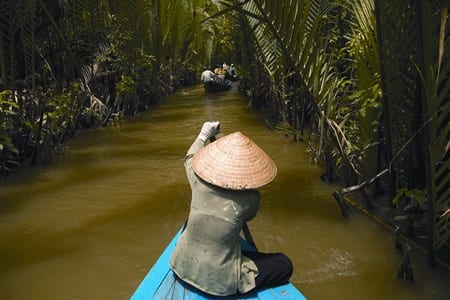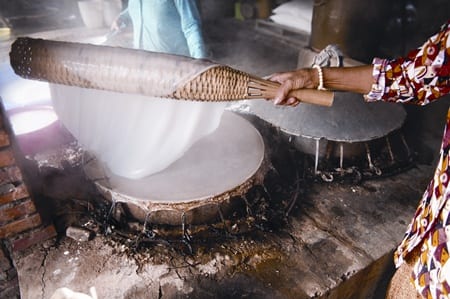Meandering on the Mekong
As a visitor cruises along the Mekong River in Vietnam, he gets a rare opportunity to reach out and touch the lives of the local community for whom the river is a living lifeline By Steena Joy
Impacting the lives of 70 million people, the Mekong River is one of the world’s great river systems, flowing 4,909 km through six countries: China, Myanmar, Thailand, Laos, Cambodia and Vietnam. The river’s seasonal variation in water level and the range of wetland habitats inundated makes it a great productive source of livelihood. Not surprisingly, the Mekong River Basin’s immense biodiversity is fundamental to the rural livelihoods of people living in the Lower Mekong Basin and a tour of the Mekong Delta offers the discerning traveller a unique insight into their life on this unique waterworld.
Accessible from Ho Chi Minh City (a three hour drive on the National Route 1A freeway), a tourist’s first impression of the Mekong Delta in southern Vietnam is a vast maze of tributaries, swamps and islands, and villages surrounded by rice paddy fields and houses on stilts hugging the riverbank. Giving colour to the scene is an amazing business idea – floating markets. Boats in the Mekong Delta are not only the main means of transportation, but they are also used to sell fruits, flowers and vegetables. Many of the vendors live on these boats, family et al.
One of the most famous is the Cai Be floating market. Locals say that earlier about 15 years ago, there were around 15 big floating markets in the Mekong Delta but now their numbers have decreased. The reasons are twofold. Firstly, earlier local people used canals and waterways in the Mekong Delta for travel but being a developing economy, infrastructure has improved so less people are buying boats; instead they are buying trucks or cars using the road rather than the river. Secondly, unlike previously, most parents want to educate their children so they send them to Ho Chi Minh City or Can Tho, the main city in the heart of the delta and once they finish their education they do not want to return to traditional occupations. Disturbed by the declining number of floating markets, local authorities are working on finding a solution to preserve these markets. These markets are at their best in the early hours of morning.
As you cruise further along, a huge Catholic cathedral on the riverside catches attention amidst the lush green landscape. The tour then halts at a village on the riverbank.
Experiential tourism
At the village, smiling faces greet you and friendly villagers make tourists feel welcome. Here one can get a glimpse into the traditional occupations in the Mekong Delta like bee keeping and making coconut candies. Local families do everything themselves: they husk the coconuts and then extract the coconut milk. This milk is then combined with salt and sugar and the mixture is heated in large pans to make the candies. Peanuts, chocolate and other ingredients are then added for different flavours. They are then packaged into little squares. Visitors can sample these candies and are encouraged to buy these local products to support the community.
Moving ahead, at a village house local fruits like jackfruit, rambutan are served while locals played music on traditional instruments like the dan bau, a one stringed instrument that dates back to the 18th century and is made from wood and water buffalo horn. The word bau means gourd and refers to the dried gourd fastened to the handle, surrounding the string at the point where it connects to the handle. In the past, this gourd may have served as a resonator, but today it is just a decorative feature.
Later, a ride in traditional canoes rowed by oarsmen or women in the trademark conical Vietnamese hats takes visitors down a tributary into swamplands and marshlands that dot the delta landscape. Back on the boat, the next stop is another village where bicycles can be hired for touring the countryside, winding the way along rice paddy fields, fruit orchards and swaying coconut palms.
A visit to the giant brick kilns shaped like huge pagodas along the river is also a must. Though polluting, brick making was a thriving industry in the delta region because the river made it easier to transport heavy materials like clay. However, most of these family owned enterprises are now shut down due to lack of demand from cities and newer less polluting methods of brick making. The next stop is at a local mat weaver. Mat and roof thatching are other sources of livelihood for people in the Mekong Delta.
Mekong’s rice secrets
Known as the ‘rice bowl’ of Vietnam, Mekong farmers produce about 7.1 million tons of rice a year. The dramatic expansion of rice production and exports in Vietnam has stimulated investment to modernise the rice milling sector and build new large-scale rice mills, particularly in the Mekong Delta. Huge boats carrying tons of rice make their way from different regions of the country to the Mekong Delta for milling and processing. So visitors should not miss the opportunity of taking a tour of a rice mill to understand the importance of rice in the delta region.
Villagers on the Mekong River, have also found other rice-related businesses. Visitors are sure to notice a lot of thin round wet paper-like discs drying on bamboo screens everywhere. These are banh trang or thin rice papers, used in making spring rolls, a popular Vietnamese food. The making of banh trang is an industry in itself giving local farmers and their families a chance to earn money. Rice paper is made using white rice flour, tapioca flour, salt, and water. The tapioca powder makes the rice paper glutinous and smooth. Banh trang is usually sold dried in thin, crisp, translucent round discs, which when dipped briefly in water becomes soft and can be wrapped around savoury or sweet fillings. Rice paper was a central feature in the opening scenes of the American TV show Kung Fu, where the young Kwai Chang Caine rolled out a long length of rice paper and walked on it, trying to leave behind no trace of his passage.
The villages along the Mekong River also make pop rice, a Vietnamese version of Rice Krispie Treats. The taste is somewhat close to popcorn and as no oil is used, pop rice is healthy. The process used is very similar to that in India. Rice is heated in a wok-shaped cooking vessel with hot black sand. After all the rice finishes popping, the pop rice is put into sieves hung from the ceiling to remove the sand.
Homestay on the riverbank
Located right on the bank of the Mekong river, the Ba Duc homestay is ideal for a stopover to discover and experience the customs and culture of people in the Mekong Delta at a leisurely pace. Built in 1850 and reconstructed in 1938 by Phan Van Dang, the house has a colonial look combining two architectural styles: Vietnamese and French. It is only one of the few houses on the bank that has been built on a higher foundation to protect from flooding in the rainy season. Guests can wander around the three-hectare precinct full of ornamental plants and fruit trees. Some of the activities guests can indulge in are bicycling tours into the nearby village, paddy sowing and scoop ditch fishing or fish slapping (a unique way of fishing where you wade into a narrow and shallow mud filled water ditch, set up your net and slap the water driving the fish into the net).





